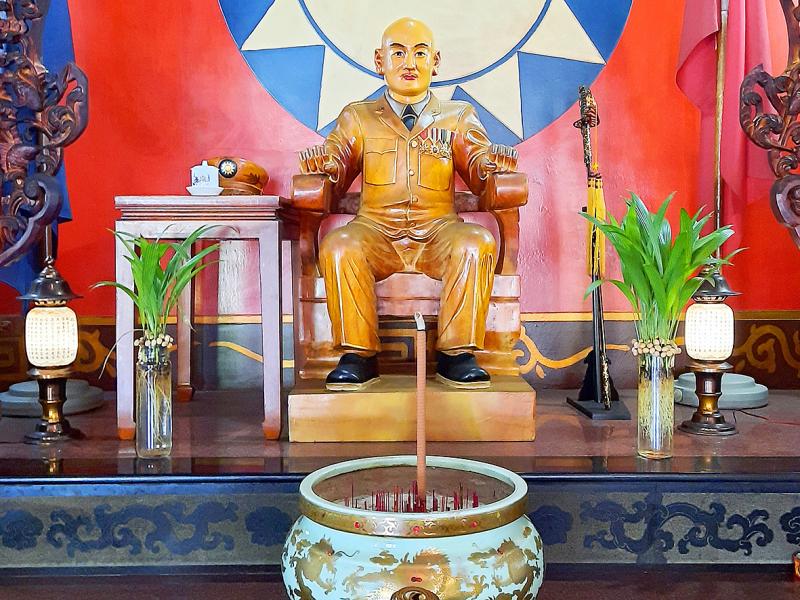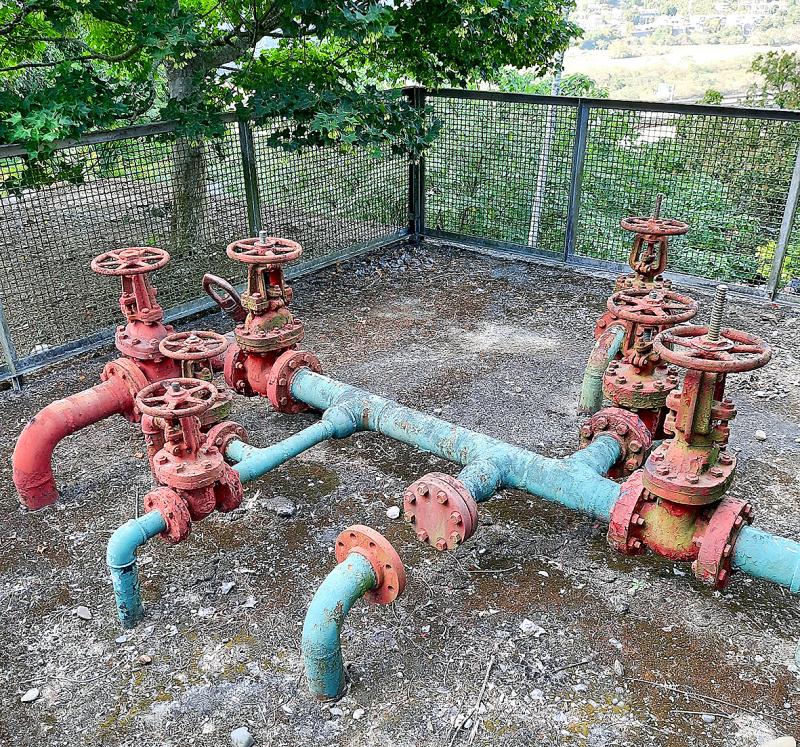I’ve reached the end of this particular road. After 49 months and 171 articles, Highways & Byways is retiring to make room for other voices.
I’ll still be contributing the occasional travel piece to this newspaper, and continuing my twice-a-month environment column. From now on, however, I can be a selfish sightseer.
When I go someplace by bus, no longer will I keep an eye out for parking spots. If I ride my motorcycle, I needn’t spare a thought for those who want to get to the same place using public transportation. And on scorchingly hot days, if I don’t feel like walking any further, I won’t — even if I suspect there’s something around the corner that Taipei Times readers may find interesting.

Photo: Steven Crook
Don’t get me wrong: I’ve relished each and every excursion. It’s been worth the occasional blister, sunburn and mosquito bite to see so much of Taiwan. A few destinations have disappointed, but they’re far outnumbered by places that exceeded expectations. And I can’t think of a single trip I regret making.
UNCOVERING THE OBSCURE
People who ask me how I find some of the more obscure attractions I’ve covered in Highways & Byways often express surprise when I tell them that maps are more useful than social media. For instance, it was on an online map that I first noticed the former Imperial Japanese Navy Wireless Communications Station (原日本海軍鳳山無線電信所) in Kaohsiung (“Radio waves,” Oct. 26, 2018).

Photo: Steven Crook
Gazing at maps isn’t my only old-school habit. On buses and trains, while other passengers are mesmerized by their smartphones, I look out of the window. Itching to access a wild valley I could see from the Kaohsiung-to-Taitung express, on one journey to the east I studied the unpaved road that runs parallel to the South Link Line (南迴鐵路) with the intensity of a spy.
Several weeks later, I returned on my bike and spent a memorable day exploring the Fangshan Creek (枋山溪) watershed. My writeup of that expedition (“A road built for trainspotting”) appeared on Nov. 30, 2018.
Last year, a friend told me that the elevated steel roadway mentioned in my article has been dismantled. Cyclists now have to ride on gravel and cross multiple creeks — which just goes to show that anything I write should be regarded as a snapshot. Thanks to earthquakes and typhoons, few of Taiwan’s landscapes are permanent, even where human impact is minimal.

Photo: Steven Crook
Unlike the highly popular South Link Line, Taiwan’s early enthusiasm for nuclear energy aroused determined opposition. Perhaps it isn’t surprising that the scientists who operate the country’s only research reactor were eager to show me around and explain how nuclear technology can benefit humanity (“The pool of blue light,” Jan. 17, 2020).
AVOIDING THE USUAL ANGLES
Taiwan travel writing is dominated by food, mountains and religious culture. So finding a good topic, like the research reactor, that’s unconnected to any of those themes, gives me a special sense of satisfaction. This, along with my love of industrial heritage, made visiting and writing up the oil-field relics of Chukuangkeng (出礦坑) (“Petroleum and popsicles in back-country Miaoli,” May 28, 2021) one of last year’s highlights. Earlier I alluded to destinations that turned out to be far more engrossing that I’d dared hope. Chukuangkeng falls into that category, for sure.

Photo: Steven Crook
Stumbling across a place of interest that doesn’t appear on maps — and which all but a few Chinese-language bloggers ignore or remain ignorant of — is another delight, especially if it may be connected to a murky episode in Taiwan’s history. Mount Ganlan (橄欖山) isn’t much of a hill, but some say that soldiers trained here because former president Chiang Kai-shek (蔣介石) planned to send an expeditionary force to Vietnam. This army, the dictator hoped, would not only assist the South Vietnamese and their American allies, but also expand the anti-communist war into China (“A Cold War relic in rural Tainan” Jan. 4, 2019).
If Chiang’s influence intrigues you, look at a piece I wrote about Kaohsiung’s Cijin (旗津), where he’s been elevated to a minor deity (“The waves of history that washed over Cijin,” Oct. 30, 2020).
When planning a research trip, it’s impossible to predict just how much text I’ll get out of a half day or a whole day on-site.

Photo: Steven Crook
Eight hours on Cijin resulted in two lengthy articles. One featured the shrines where the dead dictator is honored. The other focused on those at the opposite end of the power spectrum: female factory workers who drowned, and whose posthumous status reflects ancient thinking about marriage and lineage (“The 25 women of Cijin,” Sep. 25, 2020).
By contrast, I devoted two full days to the Canal Greenway (水圳綠道), Taiwan’s longest bike-only trail, for just one article (“Burned up and washed out,” Jun. 3, 2022). And I didn’t even get the satisfaction of completing an end-to-end ride.
NOT LEISURE
.jpg)
Photo: Steven Crook
Some people who’ve never tried their hand at travel writing don’t realize that two days of travel research isn’t the same as a two-day leisure trip. If I go somewhere with the intention of writing about it, there’s a constant and nagging concern that I might miss something of significance, and feel foolish when a reader asks: “But what about the…?”
I have to be flexible when I’m on the road. The weather doesn’t always cooperate. Sometimes the opening hours listed on a Web site aren’t accurate. But lingering at a place just because I’m enjoying myself is seldom an option. After gathering hard facts and personal impressions, and taking some photos, I have to move on. As you might imagine, I’m looking forward to again being able to really smell the flowers. Or the dumplings. Or the sea breezes. Or the incense.
There’s only one way to end this article, and that’s with a shout out to all the Taiwanese who’ve helped me, both during my travels and afterward by answering questions on subjects as diverse as architecture and waterbirds. I hardly ever tell the individuals I meet why I’ve gone to a particular place, so you can be sure this hospitality isn’t motivated by a desire to present Taiwan in the best possible light. And I know I’m not the first outsider to say this: People, as much as natural scenery and culture, are this country’s greatest asset.
Steven Crook has been writing about travel, culture and business in Taiwan since 1996. He is the author of Taiwan: The Bradt Travel Guide and co-author of A Culinary History of Taipei: Beyond Pork and Ponlai.

Exceptions to the rule are sometimes revealing. For a brief few years, there was an emerging ideological split between the Democratic Progressive Party (DPP) and Chinese Nationalist Party (KMT) that appeared to be pushing the DPP in a direction that would be considered more liberal, and the KMT more conservative. In the previous column, “The KMT-DPP’s bureaucrat-led developmental state” (Dec. 11, page 12), we examined how Taiwan’s democratic system developed, and how both the two main parties largely accepted a similar consensus on how Taiwan should be run domestically and did not split along the left-right lines more familiar in

As I finally slid into the warm embrace of the hot, clifftop pool, it was a serene moment of reflection. The sound of the river reflected off the cave walls, the white of our camping lights reflected off the dark, shimmering surface of the water, and I reflected on how fortunate I was to be here. After all, the beautiful walk through narrow canyons that had brought us here had been inaccessible for five years — and will be again soon. The day had started at the Huisun Forest Area (惠蓀林場), at the end of Nantou County Route 80, north and east

Specialty sandwiches loaded with the contents of an entire charcuterie board, overflowing with sauces, creams and all manner of creative add-ons, is perhaps one of the biggest global food trends of this year. From London to New York, lines form down the block for mortadella, burrata, pistachio and more stuffed between slices of fresh sourdough, rye or focaccia. To try the trend in Taipei, Munchies Mafia is for sure the spot — could this be the best sandwich in town? Carlos from Spain and Sergio from Mexico opened this spot just seven months ago. The two met working in the

This month the government ordered a one-year block of Xiaohongshu (小紅書) or Rednote, a Chinese social media platform with more than 3 million users in Taiwan. The government pointed to widespread fraud activity on the platform, along with cybersecurity failures. Officials said that they had reached out to the company and asked it to change. However, they received no response. The pro-China parties, the Chinese Nationalist Party (KMT) and Taiwan People’s Party (TPP), immediately swung into action, denouncing the ban as an attack on free speech. This “free speech” claim was then echoed by the People’s Republic of China (PRC),